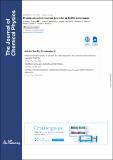| dc.contributor.author | Williams, Nicholas J | |
| dc.contributor.author | Warburton, Robert E | |
| dc.contributor.author | Seymour, Ieuan D | |
| dc.contributor.author | Cohen, Alexander E | |
| dc.contributor.author | Bazant, Martin Z | |
| dc.contributor.author | Skinner, Stephen J | |
| dc.date.accessioned | 2024-10-28T18:10:00Z | |
| dc.date.available | 2024-10-28T18:10:00Z | |
| dc.date.issued | 2023-06-28 | |
| dc.identifier.uri | https://hdl.handle.net/1721.1/157438 | |
| dc.description.abstract | Understanding the charge transfer processes at solid oxide fuel cell (SOFC) electrodes is critical to designing more efficient and robust materials. Activation losses at SOFC electrodes have been widely attributed to the ambipolar migration of charges at the mixed ionic–electronic conductor–gas interface. Empirical Butler–Volmer kinetics based on the transition state theory is often used to model the current–voltage relationship, where charged particles transfer classically over an energy barrier. However, the hydrogen oxidation/water electrolysis reaction H2(g) + O2− ⇌ H2O(g) + 2e− must be modeled through concerted electron and proton tunneling events, where we unify the theory of the electrostatic surface potential with proton-coupled electron transfer kinetics. We derive a framework for the reaction rate that depends on the electrostatic surface potential, adsorbate dipole moment, the electronic structure of the electron donor/acceptor, and vibronic states of the hydrogen species. This theory was used to study the current–voltage characteristics of the Ni/gadolinium-doped ceria electrode in H2/H2O(g), where we find excellent validation of this novel model. These results yield the first reported quantification of the solvent reorganization energy for an SOFC material and suggest that the three-phase boundary mechanism is the dominant pathway for charge transfer at cermet electrodes. | en_US |
| dc.language.iso | en | |
| dc.publisher | AIP Publishing | en_US |
| dc.relation.isversionof | 10.1063/5.0145247 | en_US |
| dc.rights | Creative Commons Attribution | en_US |
| dc.rights.uri | https://creativecommons.org/licenses/by/4.0/ | en_US |
| dc.source | AIP Publishing | en_US |
| dc.title | Proton-coupled electron transfer at SOFC electrodes | en_US |
| dc.type | Article | en_US |
| dc.identifier.citation | J. Chem. Phys. 158, 244107 (2023) | en_US |
| dc.contributor.department | Massachusetts Institute of Technology. Department of Chemical Engineering | en_US |
| dc.contributor.department | Massachusetts Institute of Technology. Department of Mathematics | en_US |
| dc.relation.journal | The Journal of Chemical Physics | en_US |
| dc.eprint.version | Final published version | en_US |
| dc.type.uri | http://purl.org/eprint/type/JournalArticle | en_US |
| eprint.status | http://purl.org/eprint/status/PeerReviewed | en_US |
| dc.date.updated | 2024-10-28T17:43:17Z | |
| dspace.orderedauthors | Williams, NJ; Warburton, RE; Seymour, ID; Cohen, AE; Bazant, MZ; Skinner, SJ | en_US |
| dspace.date.submission | 2024-10-28T17:43:23Z | |
| mit.journal.volume | 158 | en_US |
| mit.journal.issue | 24 | en_US |
| mit.license | PUBLISHER_CC | |
| mit.metadata.status | Authority Work and Publication Information Needed | en_US |
